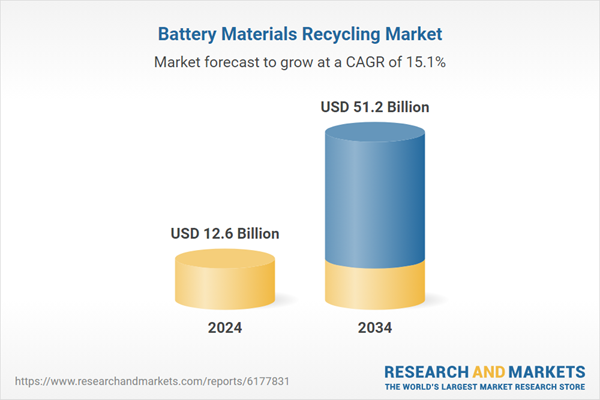Demand for key battery metals like lithium, cobalt, manganese, and nickel is surging as the electric vehicle and renewable energy sectors expand. Recycling these materials is gaining traction as a sustainable alternative to traditional mining, offering a solution to volatile raw material pricing, geopolitical uncertainty, and environmental degradation. The market is being further propelled by regulatory reforms, which are evolving rapidly across key regions to encourage resource circularity and improve battery end-of-life management. These changes are fostering long-term growth prospects and enabling robust private and public sector investments in recycling ecosystems.
Increasing global attention toward sustainable supply chains is reinforcing the need for circular economies in energy storage and electric mobility. Recycling is not only seen as an eco-conscious approach but also as a strategic tool for reducing dependency on virgin material extraction. One of the key trends reshaping the industry is the vertical integration of recycling operations into battery manufacturing supply chains. This integration is helping manufacturers close the loop, ensuring stable sourcing of high-value recovered materials while improving cost efficiency and regulatory compliance throughout production lifecycles.
The lithium recovery segment generated USD 2.9 billion in 2024 and is expected to grow at a CAGR of 13.9% from 2025 to 2034. Lithium continues to dominate due to its high demand in lithium-ion batteries used across EVs, portable electronics, and grid-scale storage systems. With advancements in techniques such as direct lithium extraction and hydrometallurgical processes, lithium recovery is becoming more efficient, further fueling its dominance within the battery materials recycling market. The rising use of these technologies enhances extraction yields, which is making recycling increasingly viable at a commercial scale.
The automotive battery segment generated USD 6 billion in 2024 and is projected to grow at a CAGR of 14.5% through 2034. The segment growth is fueled by the ongoing acceleration of global EV adoption, which is creating enormous volumes of spent lithium-ion batteries. Automakers and battery suppliers are forming strategic collaborations with recyclers to build closed-loop systems that reclaim metals such as lithium, cobalt, and nickel for reuse in new battery production. These systems are playing a key role in reducing the environmental impact of EV growth and ensuring more resilient supply chains.
China Battery Materials Recycling Market generated USD 3 billion in 2024 and is expected to grow at a CAGR of 15.3% through 2034. The country has implemented strict battery recycling regulations and possesses the industrial scale to support the growth of advanced recovery technologies. Meanwhile, India is quickly emerging as a promising market, with new regulations and investments strengthening its recycling capabilities. Countries like Australia, Indonesia, and Thailand are also accelerating infrastructure development to support battery material recovery as their EV and electronics sectors expand.
Leading companies driving innovation and expansion in Global Battery Materials Recycling Market include Stena Recycling, Redwood Materials, Ascend Elements, TES (part of SK Ecoplant), Umicore, LG Energy, RecycLiCo Battery Materials Inc., Duesenfeld GmbH, Primobius GmbH (Neometals JV), Glencore plc, Ecobat, Neometals Ltd, Retriev Technologies, Elemental Strategic Metals (ESM), and American Battery Technology Co. To strengthen their foothold in the battery materials recycling market, companies are pursuing strategies centered around vertical integration and technology innovation. Leading players are partnering with automakers and battery manufacturers to create closed-loop ecosystems that facilitate direct sourcing of spent batteries. Investments are also being made in advanced hydrometallurgical and direct extraction technologies to improve material recovery rates and reduce processing costs. Firms are expanding their global footprint by setting up regional recycling hubs and forming joint ventures to localize collection and refining operations.
Comprehensive Market Analysis and Forecast
- Industry trends, key growth drivers, challenges, future opportunities, and regulatory landscape
- Competitive landscape with Porter’s Five Forces and PESTEL analysis
- Market size, segmentation, and regional forecasts
- In-depth company profiles, business strategies, financial insights, and SWOT analysis
This product will be delivered within 2-4 business days.
Table of Contents
Companies Mentioned
The companies profiled in this Battery Materials Recycling market report include:- American Battery Technology Co
- Ascend Elements
- Duesenfeld GmbH
- Ecobat
- Elemental Strategic Metals (ESM)
- Glencore plc
- LG Energy
- Neometals Ltd
- Primobius GmbH (Neometals JV)
- RecycLiCo Battery Materials Inc.
- Redwood Materials
- Retriev Technologies
- Stena Recycling
- TES (part of SK ecoplant)
- Umicore
Table Information
| Report Attribute | Details |
|---|---|
| No. of Pages | 235 |
| Published | September 2025 |
| Forecast Period | 2024 - 2034 |
| Estimated Market Value ( USD | $ 12.6 Billion |
| Forecasted Market Value ( USD | $ 51.2 Billion |
| Compound Annual Growth Rate | 15.1% |
| Regions Covered | Global |
| No. of Companies Mentioned | 16 |









